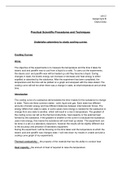Essay
BTEC Applied Science Unit 2 Assignment B - Cooling Curves
- Vak
- Instelling
BTEC Applied Science Unit 2 Assignment B - Cooling Curves. Includes Cooling Curve of Stearic Acid and Paraffin Wax. Includes pictures, graphs and tables. Referenced throughout. Awarded a DISTINCTION.
[Meer zien]




